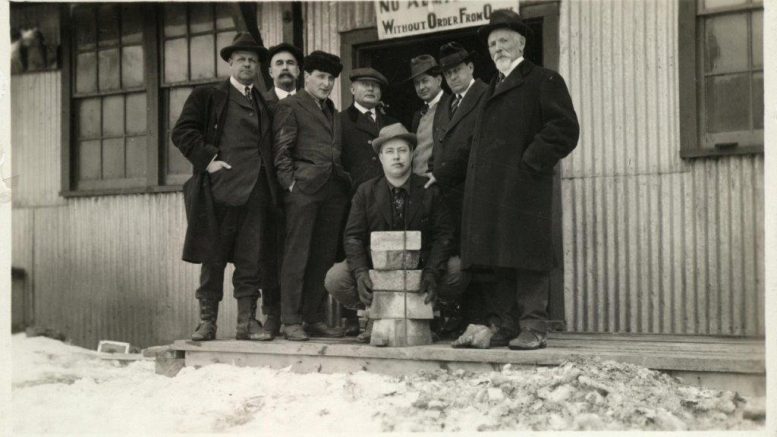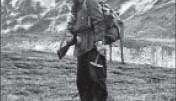The would-be millionaire John Paris Bickell had first become interested in the metals of the earth during a trip to the Yukon goldfields as a young man. Then, in 1903, the Cobalt silver strike near Lake Temiskaming signalled the beginning of Ontario’s own mineral “Klondike.”
The find attracted many optimistic prospectors to stake their claims; along with their dreams, they rode north on the railroads that were being built to link these remote areas to the south. Toronto, with its stock exchange, would become the storefront for the precious metals mining trade.
After the Cobalt strike, J.P. secured seats on the Standard Stock and Mining Exchange. Like so many others he continued to keep a sharp eye on Cobalt, and soon he went into business with mining mogul Burr Cartwright. Their relationship was further galvanized when things started to heat up in the Temiskaming area. The mine Cartwright oversaw was prosperous, and Bickell benefited from this relationship by helping Cartwright develop his silver mine.

John Paris Bickell. Credit: MacLachlan Family Collection.
Bickell became even further invested in mining in 1906, when William G. Trethewey sold his eponymous silver mine for $1 million to a group that included Bickell and the English investor Colonel Alexander Hay.
Yet it was gold that had the widest appeal. The Porcupine Gold Rush of 1909 profoundly affected not only Ontario’s hinterland and the small towns north of Sudbury, but also the entire province. The development of its mining industry and the investments in mining paid dividends for Ontario and its residents, and contributed to an overall higher standard of living.
Bickell was still young. Having developed the silver mine at Cobalt, and with that trip to the Yukon goldfields still haunting his imagination, he now set his sights on the yellow metal of Timmins.
The McIntyre Porcupine gold mine was one of the most important gold strikes in Canadian history. Three mines — Hollinger, Dome and McIntyre — were discovered by separate prospectors within a few miles of each other and were at the heart of the gold rush. The Big Three, which would subsequently control 90 percent of the region’s gold production, collectively produced over 67 million ounces of gold during the twentieth century, and were responsible for the establishment of the city of Timmins, Ontario.
The region’s early stakes had been courtesy of the Scotsman Sandy McIntyre (a.k.a. Alexander Oliphant), who had left Glasgow for Canada in 1903. McIntyre would soon become central to the J.P. Bickell story.
Along with a German-born prospector named Hans Buttner, McIntyre travelled the shores of Pearl Lake in search of gold. In 1909, on the very same day that the Hollinger team made its discovery, McIntyre and Buttner found visible gold.

Sandy McIntyre (left) and Hans Buttner staking the McIntyre mine claim in Ontario in 1909. Credit: MacLachlan Family Collection.
The pair subsequently staked claims and went about developing what would become the McIntyre mine, which would forever change this entire region of Ontario.
The man known in Glasgow as Alexander Oliphant had unceremoniously left his wife back in Scotland before sailing to Canada under his new name, McIntyre.

Sandy McIntyre, discoverer of the McIntyre gold mine in Schumacher, Ont., on Oct. 23, 1909. Credit: MacLachlan Family Collection.
It was no secret that Sandy was overly fond of alcohol, a common trait among the prospectors of his era. Living up to the cliché, however, cost him dearly.
Indeed, McIntyre must have been thoroughly sloshed when he sold off his stakes in the Porcupine for such laughably low fees. He sold a quarter-interest, for instance, to Weldon Young of Ottawa for a paltry $300. That same day he sold an eighth-interest to Jim Hughes for a mere $25. Later, he sold a half-interest to A.J. Young of North Bay for $5,000. There was a $60,000 option included in that deal, but McIntyre was apparently tricked out of it.
In the end, McIntyre had sold his 1909 stakes for a pittance when one considers the millions that would one day be mined out of the Porcupine.
In what can only be regarded as a compassionate move, McIntyre Porcupine Gold Mines Ltd. gave Sandy a pension to see him through his later years.
 — The preceding is an excerpt from the newly released biography of Canadian Mining Hall of Fame inductee, John Paris Bickell, entitled: J.P. Bickell: The life, the Leafs and the legacy.
— The preceding is an excerpt from the newly released biography of Canadian Mining Hall of Fame inductee, John Paris Bickell, entitled: J.P. Bickell: The life, the Leafs and the legacy.
Jason Wilson is a best-selling Canadian author, two-time Juno Awards nominee and an adjunct professor at the University of Guelph. Kevin Shea is a hockey historian and best-selling author of 16 hockey books. Graham MacLachlan is a relative of J.P. with an extensive business background in international trade.
The book is available at www.dundurn.com. Graham MacLachlan is donating his proceeds from book sales to Camp Bickell near Timmins, Ontario.





Be the first to comment on "Book excerpt: Budding mogul J.P. Bickell’s hunt for gold in Ontario"